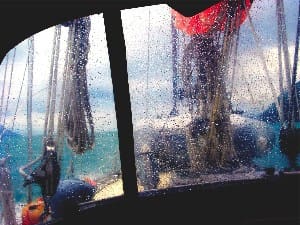
Blakes schooner Seamaster, looking more ship-like than anything else in the Newport (R.I.) Shipyard with its bare aluminum hull, will continue to serve Blakexpeditions on environmental causes.
Since the murder of Sir Peter Blake at the hand of pirates aboard Seamaster in the Amazon wilderness last December, the fate of Blakexpeditions and the 119-foot research schooner have been uncertain. The loss of the charismatic sailor and champion for the environment has been a blow to the fledgling organization and to all who knew him. The New Zealand yachtsman formed the foundation, Blakexpeditions, in 2000. According to his close friend Chris Coffin, who is also director of Blakexpeditions Foundation (USA), Blake was interested in a different lifestyle after retiring from yacht racing. "Pete was looking for a way to give back; he had seen declines in species of birds such as the Southern albatross and other animals and marine mammals as a result of pollution and over fishing … he wanted a way to raise environmental awareness." And to that end, with the help of private and corporate sponsorship, Blakexpeditions was formed. Aboard Seamaster, the foundation's mission was to conduct research and to educate people about the threats facing our planet's ecosystems. Their objective: to protect the waters of the world and the creatures that inhabit them. During voyages they spread the word using the latest in communications technology, and produced documentary videos of their travels. A sophisticated website provided photos, log updates, schedules and commentary on the trips. The first major expedition to Antarctica in 2001 investigated the effect of global warming on the polar region. Seamaster ventured as far as 70° south in the George VI Sound, farther south, as far as can be ascertained, than any vessel has reached before. Chris Coffin and his son accompanied Blake on the Antarctic trip, which produced a two-hour documentary entitled Heart of Ice.The second trip, an Amazon expedition, began in September 2001. The team explored the Amazon and its tributaries, dispatching a jungle team that spent several weeks traveling the Casiquiare and the upper Orinoco River. Here, the focus was on the effect of the logging industry on air quality and the fauna and flora of the region. A documentary of the trip is in production. The expedition was complete when tragedy struck December 5, 2001, the night before Seamaster was scheduled to leave the area. Since Sir Peter's death, Blakexpeditions has been moving forward. There is a strong desire among sponsors and partner organizations such as the United Nations Environment Programme to continue Blake's legacy and use Seamaster as an educational platform and research tool. Lady Pippa Blake and her children also continue to play a key role in the move forward. The foundation's plan is to continue with a voyage schedule after a refit in Newport. Their goal over the next five years will be to visit Newfoundland, Greenland, transit the Northwest Passage, explore coral reefs of the South Pacific, and circumnavigate Antarctica. There are plans to overhaul the organization's website to make it an even better tool for environmental education. A pilot program with schools in New Zealand is also in the works. Sadly, Peter Blake is gone. For his family and those who worked with him, his shoes can never be filled, but his legacy lives on in the foundation's mission.

